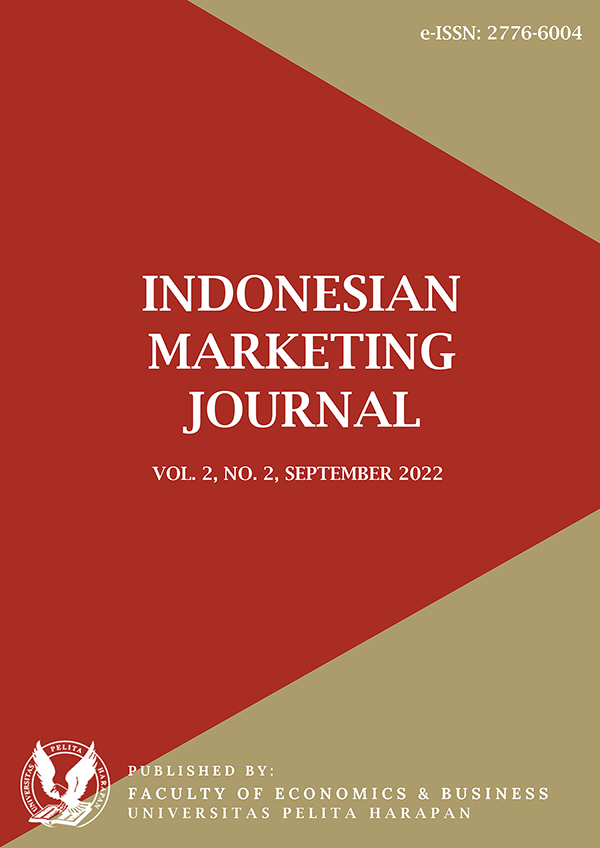THE EFFECT OF PRODUCT QUALITY AND SERVICE QUALITY ON CONSUMER SATISFACTION AND REPURCHASE INTEREST (STUDY AT STARBUCKS)
DOI:
https://doi.org/10.19166/imj.v2i2.6762Keywords:
Product, Service Quality, Customer Satisfaction, Intention to BuyingAbstract
This study tested and analyzed product quality, service, customer satisfaction, and consumer repurchase interest at Starbucks Indonesia. The research population sample is Starbucks Indonesia Consumers with a sample size of 105 respondents. In testing the data analysis hypothesis using SPSS Version 21.0, the results show that product quality and service quality significantly affect consumer satisfaction. Product quality and consumer satisfaction affects repurchase intention, but service quality has no significant effect on the repurchase intention.
References
Adiningrum, T., Wihardini, D., & Warganegara, D. L. (2013). Awareness or understanding? A case study of assessing Indonesian academic staff understanding of plagiarism. Education and Society, 31(1), 69-81. http://dx.doi.org/10.7459/es/31.1.06
Bouman, M., & van der Wiele, T. (1992). Measuring service quality in the car service industry: building and testing an instrument. International Journal of Service Industry Management, 3(4), 4-16. http://dx.doi.org/10.1108/09564239210019441
Cahyono, M. (2008). Pengaruh kualitas layanan terhadap kepuasan pelanggan Brown Salon di Tunjungan Plaza Surabaya [Doctoral dissertation, Petra Christian University]. Petra Christian University Scientific Repository. https://repository.petra.ac.id/737/
Ferdinand, A. (2002). Kualitas strategi pemasaran: Sebuah studi pendahuluan. Jurnal Sains Pemasaran Indonesia, 1(1), 107-119. https://ejournal.undip.ac.id/index.php/jspi/article/view/13957
Hanaysha, J. (2016). Testing the effects of food quality, price fairness, and physical environment on customer satisfaction in fast food restaurant industry. Journal of Asian Business Strategy, 6(2), 31-40. https://doi.org/10.18488/journal.1006/2016.6.2/1006.2.31.40
Haryanto, R. A. (2013). Strategi promosi, kualitas produk, kualitas layanan terhadap kepuasan pelanggan pada restoran McDonald’s Manado. Jurnal EMBA: Jurnal Riset Ekonomi, Manajemen, Bisnis dan Akuntansi, 1(4), 1406-1532. https://ejournal.unsrat.ac.id/index.php/emba/article/view/2923
Jaya, W., Arifin, R., & Slamet, A. R. (2021). Pengaruh kualitas pelayanan, kualitas produk, harga, dan lokasi terhadap kepuasan konsumen (Studi kasus pada konsumen Kafe Family Kopi di Malang). Jurnal Ilmiah Riset Manajemen, 10(1).
Kotler, P. (2000). Marketing management: edisi milenium, international edition. Prentice Hall. International, Inc.
Kotler, P., & Armstrong, G. (2001). Prinsip-prinsip pemasaran, jilid 1 (8th ed.). Erlangga.
Kotler, P., & Armstrong, G. (2016). Principles of marketing, global edition (16th ed.). Pearson Education Limited.
Kotler, P., & Keller, K. L. (2016). Manajemen pemasaran. PT. Indeks.
Lembang, R. D., & Sugiono. (2010). Analisis pengaruh kualitas produk, harga, promosi, dan cuaca terhadap keputusan pembelian teh siap minum dalam kemasan merek Teh Botol Sosro (Studi kasus pada mahasiswa Fakultas Ekonomi S1 Reguler II Universitas Diponegoro) [Doctoral dissertation, Universitas Diponegoro]. Diponegoro University Institutional Repository (UNDIP-IR).
Mowen, J. C., & Minor, M. (2002). Perilaku konsumen. Erlangga
Oliver, R. L. (1993). A conceptual model of service quality and service satisfaction: Compatible goals, different concepts. Advances in Services Marketing and Management, 2, 65-85.
Pham, Q. T., Tran, X. P., Misra, S., Maskeliunas, R., & DamaÅ¡eviÄius, R. (2018). Relationship between convenience, perceived value, and repurchase intention in online shopping in Vietnam. Sustainability, 10(1). https://doi.org/10.3390/su10010156
Puspitasari, D. (2006). Analisis pengaruh persepsi kualitas dan kepuasan pelanggan terhadap minat beli ulang (Studi kasus pada maskapai penerbangan garuda keberangkatan Semarang) [Doctoral dissertation, Universitas Diponegoro]. Diponegoro University Institutional Repository (UNDIP-IR).
Rahma, E. S. (2007). Analisis pengaruh kualitas layanan dan citra merek terhadap minat beli dan dampaknya pada keputusan pembelian (Studi pada pengguna telepon seluler merek Sony Ericson di kota Semarang) [Doctoral dissertation, Universitas Diponegoro]. Diponegoro University Institutional Repository (UNDIP-IR).
Ramli, A. H., & Sjahruddin, H. (2015). Building patient loyalty in healthcare services. International Review of Management and Business Research, 4(2), 391.
Rizan, M., & Andika, F. (2011). Pengaruh kualitas produk dan kualitas pelayanan terhadap kepuasan pelanggan (Survei pelanggan Suzuki, dealer Fatmawati, Jakarta Selatan). JRMSI-Jurnal Riset Manajemen Sains Indonesia, 2(2), 130-150. https://journal.unj.ac.id/unj/index.php/jrmsi/article/view/765
Rotter, J. B. (1966). Generalized expectancies for internal versus external control of reinforcement. Psychological Monographs: General and Applied, 80(1), 1-28. https://doi.org/10.1037/h0092976
Saidani, B., & Arifin, S. (2012). Pengaruh kualitas produk dan kualitas layanan terhadap kepuasan konsumen dan minat beli pada Ranch Market. JRMSI-Jurnal Riset Manajemen Sains Indonesia, 3(1), 1-22. https://journal.unj.ac.id/unj/index.php/jrmsi/article/view/766
Sugiyono. (2013). Metode penelitian pendidikan pendekatan kuantitatif, kualitatif, dan R&D. Alfabeta.
Sugiyono. (2019). Metode penelitian kuantitatif, kualitatif, dan R&D. Alfabeta.
Sundalangi, M., Mandey, S. L., & Jorie, R. J. (2014). Kualitas produk, daya tarik iklan, dan potongan harga terhadap minat beli konsumen pada Pizza Hut Manado. Jurnal EMBA: Jurnal Riset Ekonomi, Manajemen, Bisnis dan Akuntansi, 2(1), 235-352. https://ejournal.unsrat.ac.id/index.php/emba/article/view/3829
Zeithaml, V. A., Parasuraman, A., & Berry, L. L. (1990). Delivering quality service: Balancing customer perceptions and expectations. The Free Press.
Downloads
Published
Issue
Section
License
Authors who publish with this journal agree to the following terms:
1) Authors retain copyright and grant the journal right of first publication with the work simultaneously licensed under a Creative Commons Attribution License (CC-BY-SA 4.0) that allows others to share the work with an acknowledgement of the work's authorship and initial publication in this journal.
2) Authors are able to enter into separate, additional contractual arrangements for the non-exclusive distribution of the journal's published version of the work (e.g., post it to an institutional repository or publish it in a book), with an acknowledgement of its initial publication in this journal.
3) Authors are permitted and encouraged to post their work online (e.g., in institutional repositories or on their website). The final published PDF should be used and bibliographic details that credit the publication in this journal should be included.


